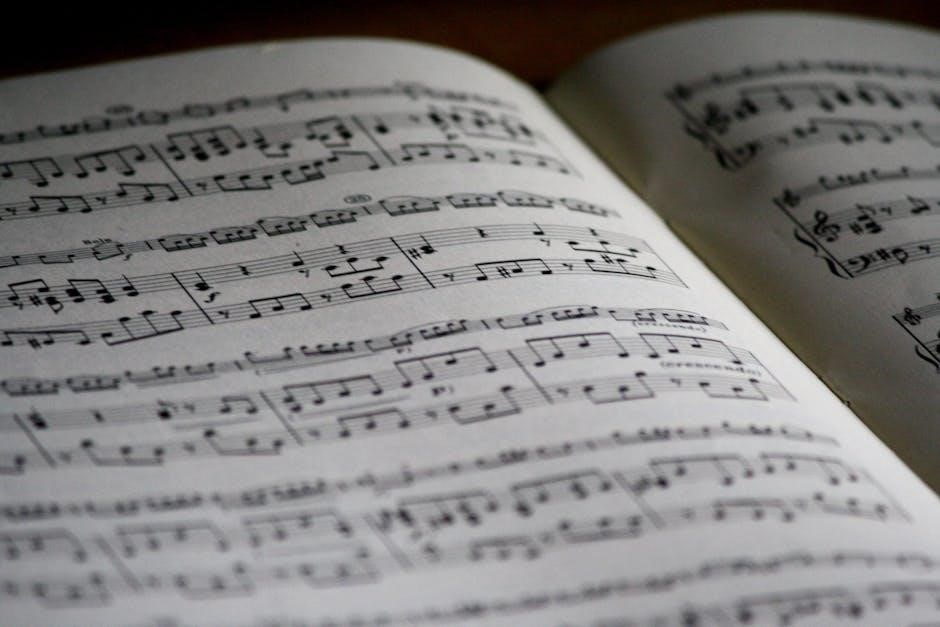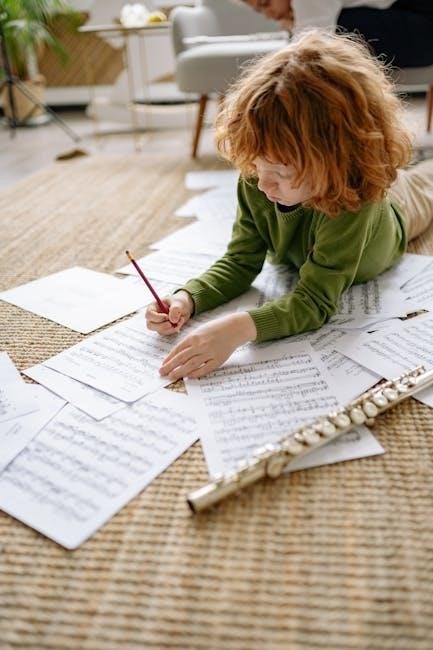
Discover the essentials of creating music through this brief guide. Learn the fundamentals of composition‚ from melody and harmony to rhythm and form. Understand how these elements work together to create meaningful musical pieces. This guide serves as a starting point for both beginners and experienced composers‚ offering insights into the creative process and the importance of music theory in crafting compelling works.
Explore the basics of musical expression‚ including the role of tempo‚ dynamics‚ and articulation. Gain practical tips on structuring your compositions and conveying emotion through sound. Whether you’re writing for personal enjoyment or professional purposes‚ this guide provides a solid foundation for your musical journey.
A Brief Overview of Musical Composition
Musical composition involves creating structured pieces using melody‚ harmony‚ rhythm‚ and form. It balances creativity with technical understanding‚ requiring knowledge of music theory and emotional expression. Composers arrange sounds to convey ideas or evoke feelings‚ often following established forms or experimenting with innovative styles. Whether for instrumental or vocal performances‚ composition is the art of organizing musical elements to communicate a unique message or tell a story through sound.
The Importance of Understanding Music Theory
Music theory provides the foundation for composing and interpreting music. It explains the structure of melody‚ harmony‚ rhythm‚ and form‚ enabling creators to craft coherent and expressive works. Understanding theory enhances creativity‚ allowing composers to experiment within established frameworks or innovate new styles. It also aids in analyzing and appreciating diverse genres‚ from classical to contemporary. Berklee College of Music and other resources emphasize its role in refining musical ideas and ensuring emotional resonance in compositions.
Essential Elements of Music
Music is built on core elements: melody‚ harmony‚ rhythm‚ and form. These components work together to create structure‚ evoke emotions‚ and convey meaning in compositions.
Melody: The Foundation of Musical Expression
Melody is the heart of music‚ serving as the primary musical line that captures the listener’s attention. It consists of a series of pitches heard in succession‚ creating a memorable and expressive sequence. A well-crafted melody can evoke emotions‚ tell a story‚ and provide the core identity of a piece. Understanding how to create melodies that resonate is fundamental to writing music that connects with audiences on a deeper level.
Harmony: Creating Depth and Complexity
Harmony adds depth and complexity to music by combining multiple pitches played simultaneously. It enhances the emotional impact of a melody and provides structural support. Understanding chord progressions‚ intervals‚ and voice leading is essential for creating harmonies that resonate. Experimenting with different harmonic techniques can elevate a composition‚ making it rich and engaging. Harmony transforms a simple melody into a layered‚ immersive experience‚ allowing for endless creative possibilities in musical expression.
Rhythm: The Pulse of Music
Rhythm is the foundational pulse of music‚ created by patterns of duration and accent. It provides structure and energy‚ guiding the listener’s experience. Tempo and time signatures define rhythm’s speed and feel‚ while syncopation and meter add complexity. Rhythmic variations can evoke emotions‚ from the calmness of a slow melody to the energy of a fast-paced beat. Mastering rhythm is essential for creating engaging and expressive musical compositions‚ as it forms the backbone of any piece.
Form and Structure: Organizing Your Composition
Form and structure are crucial for organizing a composition‚ providing a clear framework for musical ideas. Common forms include sonata‚ rondo‚ and binary‚ each offering a unique way to develop themes. Techniques like repetition and contrast create balance and interest. A well-structured piece guides the listener through a narrative‚ ensuring coherence and emotional impact. Understanding form helps composers arrange elements effectively‚ transforming raw ideas into a polished and engaging work of art.
The Process of Writing Music
The process of writing music involves finding inspiration‚ planning your composition‚ and bringing ideas to life through melody‚ harmony‚ and rhythm‚ creating a cohesive piece.
Finding Inspiration and Creativity
Finding inspiration is the spark that ignites the creative process in music writing. Drawing from personal experiences‚ emotions‚ and external influences like nature or literature can fuel ideas. Exploring diverse genres and collaborating with others can also stimulate creativity. Embracing spontaneity and experimenting with unconventional sounds or techniques can lead to unique compositions. Overcoming creative blocks requires patience and persistence‚ often achieved by setting aside time to brainstorm and explore new musical possibilities freely.
Planning Your Composition: From Idea to Reality
Planning your composition transforms a vague idea into a structured reality. Start by defining the purpose‚ mood‚ and scope of your piece. Sketch out a basic structure‚ such as intro‚ main theme‚ and conclusion. Develop a timeline and set achievable milestones. Refine your ideas through iterative drafts‚ ensuring each element aligns with your vision. Effective planning streamlines the creative process‚ turning inspiration into a cohesive and impactful musical work.
Writing the Music: Putting It All Together
Writing the music involves integrating melody‚ harmony‚ rhythm‚ and form into a cohesive piece. Begin by refining your sketches‚ ensuring each element aligns with your creative vision. Use notation software or manuscript paper to solidify your ideas. Experiment with variations and transitions to enhance flow. Regularly review and revise your work‚ seeking feedback to polish your composition. This stage is where your musical ideas truly come to life.

Songwriting Basics
Songwriting involves crafting melodies‚ lyrics‚ and harmonies to express emotions and tell stories. It balances personal expression with listener connection‚ relying on structure like verses and choruses. Creativity and practice are key to refining your unique voice and style in this universal art form.
Understanding Lyric Forms and Structures
Lyric forms provide a framework for expressing ideas and emotions coherently. Common structures include verse-chorus‚ verse-chorus-verse-chorus-bridge-chorus‚ AABA‚ and ABAC; Each form organizes lyrics to tell stories‚ convey themes‚ or evoke feelings. Understanding these structures helps create balance and flow‚ ensuring clarity and impact in your writing. Familiarity with lyric forms enhances creativity and adaptability‚ allowing you to craft meaningful and engaging songs that resonate with listeners.
Structuring a Song: Verse‚ Chorus‚ and Bridge
A song’s structure typically features verses‚ a chorus‚ and often a bridge. The verse introduces the story or theme‚ while the chorus provides a memorable‚ repetitive hook summarizing the song’s core message. The bridge offers contrast‚ adding depth or a new perspective‚ before returning to the final chorus. This framework ensures clarity‚ emotional impact‚ and audience engagement‚ making it a cornerstone of effective songwriting in various musical genres.

Advanced Techniques in Lyric Writing
Mastering advanced lyric writing involves crafting vivid imagery‚ using metaphors‚ and experimenting with wordplay to evoke emotions. These techniques enhance storytelling and deepen listener connections.
Developing Compelling and Meaningful Lyrics
Crafting compelling lyrics requires a balance of emotional depth‚ authenticity‚ and relatability. Use storytelling techniques to connect with listeners‚ employing vivid imagery and universal themes. Experiment with language to convey complex emotions succinctly. Authenticity resonates deeply‚ so draw from personal experiences or observations. Ensure your words are both specific and open to interpretation‚ allowing listeners to find personal meaning. This approach fosters a lasting emotional connection‚ making your lyrics memorable and impactful.
Using Rhyme‚ Meter‚ and Rhythm in Lyrics
Rhyme‚ meter‚ and rhythm are essential tools for crafting engaging lyrics. Rhyme adds musicality and structure‚ creating a sense of predictability and flow. Meter establishes a rhythmic pattern through syllable counts‚ guiding the natural cadence of words. Rhythm enhances emotional expression‚ aligning lyrics with melody. Experiment with rhyme schemes and meter variations to maintain interest. Use rhythm to emphasize key phrases‚ ensuring lyrics feel natural and impactful when sung. These elements work together to create memorable and resonant songs.

Exploring Musical Genres
Exploring musical genres involves understanding their unique characteristics‚ from classical to jazz. Each genre offers distinct rhythms‚ harmonies‚ and emotional expressions‚ inspiring creativity and guiding composition.
Genre-Specific Writing Tips and Tricks
Mastering genre-specific writing involves understanding its unique styles and conventions. Research the genre’s history‚ iconic pieces‚ and audience expectations. Experiment with characteristic chord progressions‚ rhythms‚ and instrumentation. Pay attention to tempo‚ dynamics‚ and emotional expression. Stay authentic to the genre’s roots while incorporating personal creativity. Collaborate with artists familiar with the genre for insights. Adapt your writing to suit the intended audience and performance setting; Continuous learning and practice will refine your genre-specific skills and versatility as a composer.
Adapting Your Style to Different Musical Genres
Adapting your style to different genres requires flexibility and openness to new sounds. Research the core elements of each genre‚ such as typical chord progressions‚ rhythms‚ and instrumentation. Experiment with these elements to create authentic pieces. Understand the audience’s expectations and emotional connections to the genre. Stay true to its roots while infusing your unique voice. Collaborate with musicians from diverse backgrounds to gain insights and refine your adaptability. This approach will broaden your creative range and enhance your versatility as a composer.

Analyzing Musical Works
Analyzing musical works involves understanding composition structure‚ identifying key elements like melody and harmony‚ and exploring the composer’s intent and emotional impact of the piece.
Understanding Musical Analysis and Criticism
Musical analysis involves breaking down a composition to understand its structure‚ themes‚ and techniques. Criticism evaluates the emotional‚ cultural‚ and technical impact of a piece. Both skills enhance comprehension of musical language‚ helping writers refine their craft by studying masterworks. Analytical tools like chord progressions‚ motif development‚ and harmonic shifts reveal a composer’s intent. Criticism provides feedback‚ guiding improvements and fostering deeper connections with audiences through informed‚ expressive writing.
Case Studies: Analyzing Famous Compositions
Examining iconic works like Beethoven’s symphonies or Bach’s fugues reveals masterful techniques. Analyzing these pieces uncovers themes‚ harmonic innovations‚ and structural brilliance. For example‚ The Beatles’ songs often showcase clever use of melody and lyrical depth. By studying these works‚ writers gain insights into composition‚ arrangement‚ and emotional impact‚ refining their skills and broadening their creative approaches to music writing.

The Role of Music Theory in Composition
Music theory is the backbone of composition‚ providing structure‚ emotional expression‚ and communication through melody‚ harmony‚ and rhythm‚ essential for creating coherent and impactful musical works.
Fundamentals of Music Theory for Writers
Music theory provides the foundation for writing music‚ offering a common language and framework. It includes understanding notes‚ scales‚ intervals‚ chords‚ rhythm‚ tempo‚ dynamics‚ and key signatures. These elements help composers create structured‚ meaningful‚ and emotionally resonant music. Grasping these basics enables writers to communicate ideas effectively‚ ensuring their compositions are coherent and expressive. Theory is not restrictive but a tool to enhance creativity and precision in musical expression.
Applying Music Theory in Practice
Applying music theory involves using its principles to craft meaningful compositions. Writers use chord progressions‚ scales‚ and rhythm to create structure and emotion. Understanding key signatures and modulations helps in developing cohesive pieces. Theory guides melody writing‚ harmony‚ and form‚ ensuring clarity and impact. It also aids in experimenting with dissonance and resolution‚ adding depth to music. This practical application transforms abstract concepts into vibrant‚ expressive works‚ balancing creativity with technical precision for effective musical communication;

Instrumentation and Orchestration
Instrumentation and orchestration involve selecting and arranging instruments to create balanced‚ expressive sounds. Proper techniques enhance a composition’s emotional depth and overall impact effectively.
Choosing the Right Instruments for Your Piece
Choosing the right instruments is crucial for achieving the desired sound and mood in your music. Consider the genre‚ mood‚ and emotional impact you want to convey. Each instrument has a unique role and timbre‚ so selecting ones that complement your composition is essential. For example‚ strings evoke warmth‚ while brass adds boldness. Experiment with combinations to find the perfect balance for your piece‚ ensuring clarity and cohesion in the overall sound.
Orchestration Techniques for Effective Sound
Effective orchestration balances texture‚ dynamics‚ and timbre to create a cohesive sound. Layering instruments strategically enhances depth‚ while contrasting sections add variety. Assigning melodic lines to instruments that showcase their range ensures clarity. Use dynamics and articulation to shape the overall sound. Experiment with harmonies and counterpoint to add complexity without overwhelming the listener. Consider the acoustic properties of each instrument to achieve a balanced and engaging orchestral texture in your composition.
Tempo and Dynamics
Tempo and dynamics are essential in music‚ controlling the speed and intensity to evoke emotions and create a dynamic sound that enhances the musical composition.
Understanding Tempo and Its Impact
Tempo‚ the speed at which music is played‚ significantly influences its mood and feel. Measured in beats per minute (BPM)‚ it dictates rhythm and pacing‚ affecting emotional expression. Faster tempos often convey energy or excitement‚ while slower ones suggest reflection or sadness. Tempo variations‚ like accelerando or ritardando‚ add dynamic changes‚ enhancing the composition’s emotional depth. Balancing tempo with other elements ensures a cohesive and impactful musical experience‚ guiding the listener’s emotional journey effectively.
Using Dynamics to Enhance Musical Expression
Dynamics‚ referring to the loudness or softness of music‚ play a crucial role in shaping emotional expression. Terms like pianissimo (very soft) and fortissimo (very loud) guide performers. Gradual changes‚ such as crescendo (increasing volume) or decrescendo (decreasing volume)‚ add depth and tension. Effective use of dynamics creates contrast‚ engages listeners‚ and enhances the overall impact of a composition‚ making it more expressive and nuanced in its delivery and interpretation.

Articulation and Expression
Articulation defines how notes are attacked and released‚ shaping the music’s clarity and feel. Expression involves phrasing‚ dynamics‚ and vibrato to convey emotion and interpret the composer’s intent effectively.
Articulation Techniques for Clarity and Precision
Articulation techniques‚ such as legato‚ staccato‚ and marcato‚ define how notes are played‚ impacting clarity and musical feel. Legato connects notes smoothly‚ while staccato separates them‚ creating crispness. Marcato emphasizes notes with a slight detachment. Accents and phrasing further refine the performance‚ ensuring precision and emotional depth. Proper articulation enhances the listener’s ability to follow melodies and rhythms‚ making it a cornerstone of effective musical expression and composition.
Conveying Emotion Through Musical Expression
Emotion in music is conveyed through dynamics‚ tempo‚ phrasing‚ and harmony. Dynamics‚ such as crescendos and decrescendos‚ create intensity or subtlety. Tempo adjustments can evoke urgency or introspection. Phrasing shapes melodies to mimic speech-like emotional contours. Harmony adds depth‚ using chord progressions to evoke tension or resolution. By mastering these elements‚ composers can craft music that resonates deeply‚ connecting with listeners on an emotional level and conveying the intended feeling with precision and authenticity.

Writing Concert Program Notes
Concert program notes provide context‚ insights‚ and historical background‚ enhancing audience understanding and appreciation of the music‚ while connecting listeners to the composer’s intent and creative vision.
A Guide to Crafting Engaging Program Notes
Engaging program notes captivate audiences by providing insightful commentary on the music‚ its history‚ and the composer’s intent. Include background on the piece‚ its premiere‚ and cultural significance. Highlight key themes‚ melodies‚ or harmonic innovations. Keep language clear and concise‚ avoiding overly technical jargon. Balance informative details with engaging storytelling to enhance listeners’ appreciation and connection to the performance. Ensure notes are well-organized and easy to follow‚ enriching the overall concert experience.
Tips for Writing Effective Concert Descriptions
Effective concert descriptions captivate audiences by blending vivid language with essential details. Highlight the program’s theme‚ key works‚ and featured artists. Provide context about the music’s historical or emotional significance. Use a clear‚ engaging tone to convey excitement and purpose. Include practical information like dates‚ venues‚ and ticket details. Ensure descriptions are concise yet informative‚ inspiring curiosity and encouraging attendance. Tailor your language to appeal to both seasoned music lovers and newcomers alike‚ fostering a connection to the performance;

Resources for Music Writers
Explore essential resources like music theory books‚ online courses‚ and composer communities. Utilize tools like DAWs‚ notation software‚ and YouTube tutorials for practical learning and inspiration.
Recommended Reading and References
Discover essential books on music theory‚ composition‚ and songwriting. Notable works include The Musician’s Guide to Theory and Analysis and Harmony and Theory. Explore genre-specific guides like Jazz Harmony and Writing Music for Film. Online resources such as PDF guides‚ academic articles‚ and composer biographies offer deeper insights. Utilize libraries like IMSLP for scores and subscribe to platforms like MasterClass for expert tutorials‚ enhancing your skills in writing in music effectively.
Online Tools and Communities for Musicians
Explore platforms like MuseScore and Flat;io for composing and collaborating. Loopmasters and Soundsmiths offer high-quality samples. Join communities on Reddit (r/WeAreTheMusicMakers) and Facebook groups like Music Production or Kompoz for feedback. Berklee College of Music and Coursera provide online courses. Utilize tools like Ableton‚ Logic Pro‚ and FL Studio for production. These resources empower musicians to refine their craft and connect with like-minded creators‚ fostering growth in writing in music effectively.
Writing in music is a fulfilling journey‚ blending creativity with technical skill. Embrace inspiration‚ refine your craft‚ and share your unique voice with the world.
Final Thoughts on Writing in Music
Writing in music is a journey of creativity and technical refinement. Embrace your unique voice‚ experiment freely‚ and stay true to your artistic vision. Persevere through challenges‚ as growth emerges from dedication and practice. Remember‚ music is a universal language‚ capable of evoking profound emotions and connections. Keep composing‚ learning‚ and sharing your passion with the world. Your music has the power to inspire and resonate with others in ways you may never imagine.
Encouragement and Next Steps for Aspiring Composers
Embark on your compositional journey with passion and resilience. Seek inspiration from diverse sources and experiment with new techniques. Collaborate with fellow musicians and embrace feedback to refine your craft. Set achievable goals‚ whether composing short pieces or exploring different genres. Stay curious‚ persistent‚ and true to your artistic vision. The world awaits your unique musical voice—share it boldly and watch your creativity flourish.
Leave a Reply
You must be logged in to post a comment.